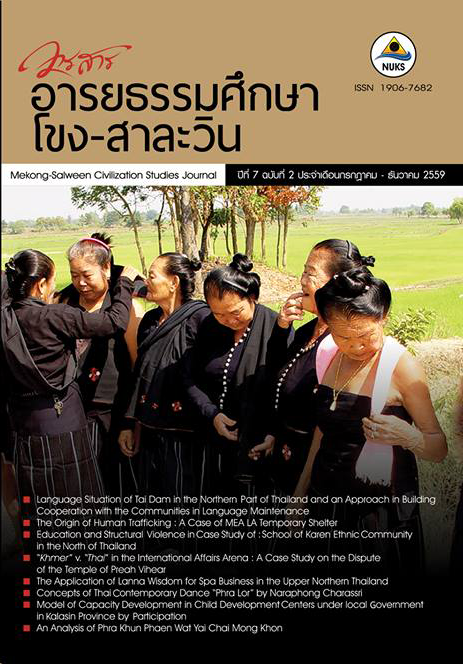“Khmer” v. “Thai” in the International Affairs Arena : A Case Study on the Dispute of the Temple of Preah Vihear
Main Article Content
Abstract
This research is a synopsis of a master degree thesis titled “Analysis
of the Rules of International Law on the Judgment of the Request for
Interpretation of the Judgment in the Case Concerning the Temple of
Preah Vihear 2013”. It aims to: 1) understand the history of the Temple of
Preah Vihear; 2) understand the ethnical disputes between Khmers and
Thais since the colonization period; 3) criticize the nationalists’ concept
regarding the International Court of Justice (ICJ)’s judgment and; 4) propose
recommendation to register the entire Dangrek mountain range as the
UNESCO’s cultural and natural world heritage site. The methodologies of
this research were conducted through qualitative analysis methods, data
collection, narrative description and content analysis.
This research found that the Temple of PreahVihear, situated on the
Dangrek mountain range, is considered sacred religious sanctuary for both
Khmers and Thais. Thereafter, a number of separation of ethnicity concepts
have been introduced; first, the concepts of “nation-state” and “border
demarcation” were inserted during the French Colonization; and second,
the “nationalism” concept was invoked by the Thai government during the
Indochina Wars. It contributed to the territorial disputes which range from
diplomatic negotiations, armed incidents and the proceedings of the ICJ in
1962. The ICJ founded that the Temple of PreahVihear was situated in territory
under the sovereignty of Cambodia. In 2008, Cambodia, which gained a
support from the Thai government, requested the UNESCO to inscribe the
Temple of PreahVihear on the World Heritage List. However, it led to invocation
of the nationalism concepts in Thailand which further aggravated the situations
since most Thais did not truly understand all the facts and backgrounds of
the Case. Recently in 2013, another ICJ decision on the Request for
Interpretation of the 1962 Judgment reaffirmed Cambodian sovereignty over
the Temple as well as its vicinity, incorporating the whole promontory upon
which the Temple is based. This Judgment was another affirmation by
international law that Thailand did not lose more territory than what it had
lost 50 years ago. Moreover, it reflected that the Temple of PreahVihear
should be considered a common heritage of mankind, rather than a symbol
for “ethnicity”, “prejudice” or “bargaining chip” in international politics of
the two nations.
The author recommended that Thailand should conduct “cultural
diplomatic approach” to request the UNESCO to inscribe the Temple of
Phanomrung on the Cultural World Heritage List, similar to the Temple of
PreahVihear in Cambodia and the Temple of Vat Phou in Laos. As all three
temples are on the Dangrek mountains range, Thailand, Cambodia and Laos
could jointly request for the inscription of the entire Dangrek mountains range
as a Natural World Heritage Site to reflect the diversity as well as the cultural
and natural value around this area which is the pride of three nations. In this
way, the world heritage concept could be used as a tool to solve conflicts
whilst bringing the citizens of the three nations together under the concepts
of equality, shared-ownership and responsibilities to protect the common
heritage of mankind in Southeast Asia.


